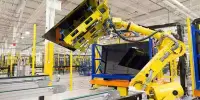There have been many developments in fields such as mobile technology, the Internet of Things (IoT), artificial intelligence (AI), and machine learning, as well as many other areas. Many of these advances have had a major impact on society and the way we live and work.
A lot has changed in technology since the dot-com boom and bust. The internet went mobile. The data center went to the cloud. Cars are now driving themselves. Chatbots have gotten pretty smart.
However, one thing has remained. When the economy declines, investors flee the market. The tech-heavy Nasdaq finished in the red for a fourth consecutive quarter, the longest such skid since the dot-bomb years of 2000 to 2001, despite a ferocious rally on Thursday. In the Nasdaq’s five-decade history, just one other negative four-quarter period occurred during the video game market meltdown in 1983–1984.
This year marks the first time the Nasdaq has ever fallen all four quarters. It dropped 9.1% in the first three months of the year, followed by a second-quarter plunge of 22% and a third-quarter decline of 4.1%. It fell 1% in the fourth quarter because of an 8.7% drop in December.
The Nasdaq lost 33% for the entire year, which was the third worst year on record and its biggest fall since 2008. The decline occurred 14 years ago, at the height of the housing crisis-induced financial catastrophe.
“It’s really hard to be positive on tech right now,” Gene Munster, managing partner of Loup Ventures, told CNBC’s Brian Sullivan on Wednesday. “You feel like you’re missing something. You feel like you’re not getting the joke.”
The only year the Nasdaq had a worse performance than 2008 was 2000, when the dot-com bubble burst and the index dropped 39%. Early hopes for the internet to rule the globe were dashed. Pets.com, infamous for the sock puppet, went public in February of that year and shut down nine months later.
EToys, which held its IPO in 1999 and saw its market cap grow to almost $8 billion, sank in 2000, losing almost all its value before going bankrupt early the next year. Delivery company Kozmo.com never got its IPO off the ground, filing in March 2000 and withdrawing its offering in August.
Amazon had its worst year ever in 2000, dropping 80%. Cisco fell 29% and then another 53% the next year. Microsoft plummeted by more than 60% and Apple by over 70%.
The parallels to today are quite stark.
In 2022, the company formerly known as Facebook lost roughly two-thirds of its value as investors balked at a future in the metaverse. Tesla fell by a similar amount, as the carmaker long valued like a tech company crashed into reality. Amazon dropped by half.
The IPO market this year was non-existent, but many of the companies that went public last year at astronomical valuations lost 80% or more of their value.
Perhaps the closest analogy to 2000 was the crypto market this year. Digital currencies Bitcoin and ether plunged by more than 60%. Over $2 trillion in value was wiped out as speculators fled crypto. Numerous businesses failed, most notably the cryptocurrency exchange FTX, which shut down after being valued at $32 billion earlier in the year. Sam Bankman-Fried, the company’s founder, is being accused of fraud.
The only major crypto company traded on the Nasdaq is Coinbase, which went public last year. In 2022, its shares fell 86%, eliminating more than $45 billion in market cap. In total, Nasdaq companies have shed close to $9 trillion in value this year, according to FactSet.
At its peak in 2000, Nasdaq companies were worth about $6.6 trillion in total, and proceeded to lose about $5 trillion of that by the time the market bottomed in October 2002.
Don’t fight the fed
Despite the similarities, things are different today.
The fall of 2022 had more to do with investors and executives realizing reality than it did with enterprises disappearing overnight, for the most part.
After a decade of development propelled by cheap money, businesses are now downsizing and being revalued. Investors no longer place a premium on rapid unprofitable expansion and have begun demanding cash generation as a result of the Fed hiking rates in an effort to control inflation.
“If you’re looking solely at future cash flows without profitability, those are the companies that did really well in 2020, and those are not as defensible today,” Shannon Saccocia, chief investment officer of SVB Private, told CNBC’s “Closing Bell: Overtime” on Tuesday. “The tech is dead narrative is probably in place for the next couple of quarters,” Saccocia said, adding that some parts of the sector “will have light at the end of this tunnel.”
She is referring to the Fed’s ongoing rate hikes, which might only come to an end if the economy experiences a recession. Both scenarios are unsettling for most of the technology industry, which thrives when the economy is expanding.
In mid-December, the Fed raised its benchmark interest rate to the highest in 15 years, lifting it to a target range of 4.25% to 4.5%. Through the epidemic and the years that followed the financial crisis, the rate was fixed close to zero.
Tech investor Chamath Palihapitiya told CNBC in late October that more than a decade of zero interest rates “perverted the market” and “allowed manias and asset bubbles to build in every single part of the economy.”
Palihapitiya took as much advantage as anyone of the cheap money available, pioneering investments in special purpose acquisition companies (SPACs), blank-check entities that hunt for companies to take public through a reverse merger.
With no yield available in fixed income and with tech attracting stratospheric valuations, SPACs took off, raising more than $160 billion on U.S. exchanges in 2021, nearly double the prior year, according to data from SPAC Research. That number sank to $13.4 billion this year. CNBC’s Post-SPAC index, comprised of the largest companies that have debuted via SPACs in the last two years, lost two-thirds of its value in 2022.
‘Bargain basement’ shopping
Predicting a bottom, as all investors know, is a fool’s errand. The economy has evolved significantly since the 2008 housing crisis and even more so since the 2000 dot-com disaster, and no two crises are comparable.
But few market prognosticators are expecting much of a bounce back in 2023. Loup’s Munster said his fund is holding 50% cash, adding that, “if we thought we were at the bottom we’d be deploying today.”
Duncan Davidson, founding partner of venture firm Bullpen Capital, expects more pain ahead as well. He looks at the dot-com era, when it took two years and seven months to go from peak to trough. As of Friday, it’s been just over 13 months since the Nasdaq hit its record price.
For private equity investors, in 2023, “I think we’re going to see a lot of bargain basement snarfing up of companies,” said Davidson, who got started in tech investing in the 1980s. To get to the market bottom, “we may have two years to go,” he said.
















